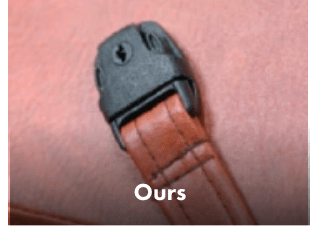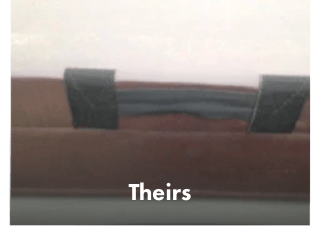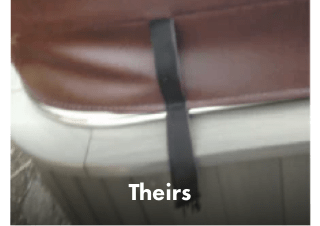Why do hot tub covers absorb water?
Hot tubs provide relaxation and enjoyment; however, many hot tub owners have reported that their coverings retain water. This issue can result in additional maintenance, higher energy expenditures, and a shorter lifespan for the cover. A cover absorbs water, making it heavier and less efficient in insulating the hot tub. In this post, we will look at why hot tubs cover collecting water, the consequences of this problem, and practical strategies to avoid and solve it.
Understanding Hot Tub Covers
Hot tub covers are essential for maintaining your hot tub's cleanliness, temperature, and efficiency. They serve several purposes:
- Heat Retention: Covers help keep the water warm, reducing the need for constant heating and thus saving on energy costs.
- Debris Protection: They keep leaves, dirt, and other debris out of the water, which helps maintain water quality.
- Safety: Covers provide a safety barrier, preventing children and pets from accidentally falling into the hot tub.
Why Do Hot Tub Covers Absorb Water?
Hot tub covers are essential for keeping your hot tub clean and efficient. However, they often absorb water for a few key reasons. This can affect how well they work and their lifespan. Let’s explore why hot tub covers soak up water and what it means for your hot tub:
Material Composition
Most hot tub covers are made from foam core wrapped in a vinyl or synthetic material. The foam core is meant to provide insulation and buoyancy. However, it can absorb water if it gets damaged or if the protective layer fails. When the outer layer of the cover is damaged, water can seep into the foam core. This leads to increased weight and reduced insulating properties.
Exposure to Elements
Hot tub covers are exposed to various environmental elements, including rain, snow, and high humidity. Over time, these conditions can cause the cover's protective vinyl layer to wear down. Even minor cracks or tears can allow water to penetrate the cover. Regular exposure to harsh weather conditions accelerates this wear and tear.
Improper Maintenance
Neglecting regular hot tub cover maintenance can lead to water absorption issues. If the cover is not cleaned and dried properly, moisture can accumulate and eventually seep into the foam core. Failure to promptly address small damages can lead to more significant issues over time.
Manufacturing Defects
Sometimes, hot tub covers may have manufacturing defects that make them more prone to water absorption. This can include issues such as improper sealing, poor quality materials, or substandard workmanship. If your cover absorbs water unusually quickly, it may be worth checking for manufacturing defects.
The Impact of Water Absorption
The impact of water absorption on hot tub covers can be quite significant. When these covers soak up water, it leads to a range of issues that can affect both your hot tub's performance and your overall experience. Let’s explore the problems that arise when hot tub covers absorb water and how they can disrupt your relaxation time:
Increased Weight
A waterlogged cover becomes significantly heavier. This makes it difficult to remove and replace, leading to inconvenience and potential damage to the hot tub or cover itself. The added weight can also strain the cover's hinges and lifting mechanisms.
Reduced Insulation
The primary function of a hot tub cover is to insulate the water. When the cover absorbs water, it loses its insulating properties. This means the hot tub has to work harder to maintain the desired temperature, leading to increased energy consumption and higher utility bills.
Shortened Lifespan
Water absorption can cause the cover's materials to break down more quickly. The foam core may become saturated, leading to deterioration and loss of structural integrity. Over time, this can significantly reduce the lifespan of the cover, necessitating frequent replacements.
Increased Maintenance
A waterlogged cover requires more frequent maintenance. The absorbed water can lead to mold and mildew growth, which not only affects the cover's appearance but can also pose health risks. Regular cleaning and drying become essential to manage these issues.
Solutions to Prevent Water Absorption
To tackle the issue of water absorption in hot tub covers, you can take several proactive steps. Here are some effective strategies to keep your cover dry and in top shape, ensuring your hot tub remains efficient and hassle-free. Let’s dive into the best practices for preventing water absorption and maintaining your cover's longevity:
Choose Quality Materials
Invest in a high-quality hot tub cover made from durable, water-resistant materials. Look for covers with reinforced vinyl and sealed seams to minimize the risk of water penetration. A well-constructed cover will provide better protection against the elements and last longer.
Regular Maintenance
Perform regular maintenance on your hot tub cover to keep it in good condition. Clean the cover periodically with a mild soap solution and a soft brush. Ensure the cover is thoroughly dried after cleaning. Inspect the cover for any signs of damage, such as cracks or tears, and repair them promptly.
Proper Storage
When not in use, store the hot tub cover in a dry, sheltered area. If possible, keep it off the ground to prevent moisture absorption from the surface. Using a cover lifter can also help reduce the risk of water accumulation by keeping the cover elevated and allowing air circulation.
Cover Protection
Consider using a cover protectant designed for hot tub covers. These products help maintain the cover’s water resistance and protect it from UV damage. Apply the protectant according to the manufacturer’s instructions for best results.
Regular Inspection
Regularly inspect your hot tub cover for signs of wear and tear. Check the seams and edges for any gaps or damage. Early detection of issues allows for timely repairs and prevents more serious problems.
Addressing Existing Water Absorption Issues
If your hot tub cover is already soaking up water, don't worry—there are ways to fix it. Here’s a practical guide to addressing and resolving water absorption issues. Follow these steps to restore your cover and get back to enjoying your hot tub with confidence:
Dry the Cover
Remove the cover from the hot tub and place it in a dry, well-ventilated area. Allow it to dry completely before attempting any repairs or reinstallation. Avoid using heat sources like direct sunlight or heaters, as these can damage the cover further.
Repair Damages
If you find any cracks or tears in the cover, repair them using a suitable repair kit. Many hot tub cover repair kits are available, including adhesive patches and sealants. Follow the instructions carefully to ensure proper repair.
Replace the Cover
If the cover is significantly damaged and cannot be effectively repaired, consider replacing it. When choosing a new cover, select one that meets your needs and offers better water resistance and durability.
Conclusion
Water absorption in hot tub covers is a common issue that can impact your hot tub's performance, lifespan, and maintenance. Understanding why water absorption happens, its effects, and how to fix the problem is key to maintaining a great hot tub experience. Choosing quality materials for your cover and performing regular maintenance can help extend its lifespan. Also, taking preventive steps will further ensure the longevity of your hot tub cover. This will lead to a cleaner, more efficient, and cost-effective hot tub.
Following these tips can better manage and prevent water absorption issues. This will help ensure your hot tub stays relaxing and enjoyable for years to come.
Our Quality
It is easy for a website to claim they have the best quality but at MySpaCover we guarantee it. We utilize only the highest quality materials and the most sophisticated processes to offer the best covers available online. Here is how our covers compare to the competition:
MYSPACOVER

Our heavy-duty handles come standard and are double stitched using marine grade vinyl to ensure the highest durability and most attractive aesthetics.

Our standard straps are double stitched and are also produced with marine-grade vinyl.

We double stitch every seam and hinge to ensure your spa cover can be used for years to come.
Other Guys

Their cheap handles are more prone to wear and tear and are known to rip off within the first two years plus the appearance speaks for itself.

Our competition uses low-quality straps that are prone to breakage and often times do not match the color of the spa cover.

Their use of single stitching and exposed shells can ultimately cause cracking and heat loss, costing you more on your electric bill.
The Underside
The underside of a spa cover is often overlooked. However, this is the material that is in constant contact with high temperatures and the chemicals in your spa. The life of your spa cover depends on a high-quality spa underside. We don’t cut corners like the other guys so you can trust that our 6 mil plastic wrap is vapor sealed to the core and will keep the heat out.
MySpaCover utilizes an 11oz PVC coated poly that, after years of rigorous testing, has proven to be the best possible material to withstand constant high temperates and chemical exposure.
Beware of mesh bottoms used by competitors as this type of material is meant to cut costs and is prone to failure.
We’ve found a few great alternatives to your selected spa cover that can reach you even quicker!
Here are the closest available alternatives based on your preferences.